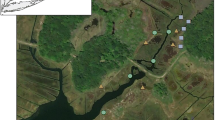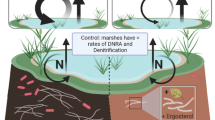Abstract
In the past century, loading of terrestrial inorganic nitrogen to coastal receiving waters has increased dramatically. Salt marshes, because of their location between upland regions and coastal waters and their recognized role as nutrient transformers, have the potential to ameliorate some of this loading. In the current study, we used core incubations in the laboratory to investigate denitrification rates in high marsh soils from five fringing salt marshes in Narragansett Bay, Rhode Island, USA. The marshes showed a wide variety of terrestrial N loading, with rates ranging from 2 to 6037 kg N ha−1 yr−1. Field-collected cores were selected to include both vegetated and bare soils at each marsh, and the six-hour incubations were designed to approximate natural tidal rhythms. Total dissolved nitrogen flux in these marshes ranged between +1255 and −710 μmol N m−2 hr−1, with N2 gas accounting for the majority of the total N flux (average 76%). Nitrogen gas flux ranged between −375 (nitrogen fixation) and +420 (denitrification) μmol N2 m−2 hr−1. While N2 gas fluxes were significantly correlated (r=+0.64, p<0.05) with marsh organic carbon content, we also detected a significant inverse relationship (r=−0.91, P<0.05) between average N2 gas fluxes and terrestrial nitrogen loads. Comparison of N2 gas fluxes in vegetated vs. bare soils indicated a significant (p <0.05) but variable effect of vegetation on N2 flux. This field survey shows the potential of New England fringe salt marshes to intercept and transform land-derived nitrogen loads; however, sediment characteristics (e.g., percent of labile organic matter) and plant community structure can significantly affect the capacity of the marsh to process inorganic nitrogen loads. In order to understand the role of salt marshes in buffering coastal N loading, we need a better understanding of the natural and anthropogenic factors controlling denitrification and net N losses.
Similar content being viewed by others
Literature Cited
An, S. and S. B. Joye. 1997. An improved chromatographic method to measure nitrogen, oxygen, argon and methane in gas or liquid samples. Marine Chemistry 59:63–70.
An, S. and S. B. Joye. 2001. Enhancement of coupled nitrification-denitrification by benthic photosynthesis in shallow estuarine sediments. Limnology and Oceanography 46:62–74.
Berner, R. A. 1971. Principles of Chemical Sedimentology. McGraw-Hill, New York, NY, USA.
Caffrey, J. M. and W. M. Kemp. 1990. Nitrogen cycling in sediments with submerged macrophytes: Microbial transformations and inorganic pools associated with estuarine populations of Potamogeton perfoliatus L. and Zostera marina. Marine Ecology Progress Series 66:147–160.
Caffrey, J. M. and W. M. Kemp. 1992. Influence of the submersed plant, Potamogeton perfoliatus L., on nitrogen cycling in estuarine sediments. Limnology and Oceanography 37:1483–1495.
Caffrey, J. M., M. C. Murrell, C. Wigand, and R. McKinney. In review. Effect of Nutrient loading on Biogeochemical and Microbial Processes in a New England High Salt Marsh, Spartina patens, (Aiton (Muhl.)), Wetlands.
Currin, C. A., S. B. Joye, and H. W. Paerl. 1996. Diel rates of N2-fixation and denitrification in a transplanted Spartina alterniflora marsh: implications for N-flux dynamics. Estuarine, Coastal and Shelf Science 42:597–616.
Dacey, J. W. H. and B. L. Howes. 1984. Water uptake by rootes controls water table movement and sediment oxidation in short Spartina marsh. Science 224:487–489.
Galloway, J. N., W. H. Schlesinger, H. Levy, A. Michaels, and J. L. Schnoor. 1995. Nitrogen fixation: Anthropogenic enhancement-environmental response. Global Biogeochemical Cycles 9:235–252.
Gosselink, J. G. and E. Maltby. 1990. Wetland Losses and Gains. p. 296–392. In M. Williams (ed.) Wetlands: a Threatened Landscape. Alden Press, Oxford, England.
Howes, B. L., P. K. Weiskel, D. D. Goehringer, and J. M. Teal. 1996. Interception of freshwater and nitrogen transport from uplands to coastal waters: the role of saltmarshes. p. 287–310. In K. F. Nordstrom and C. T. Roman (eds.) Estuarine Shores Evolution, Environments and Human Alterations. John Wiley and Sons Ltd, New York, NY, USA.
McKenna, J. H. and P. H. Doering. 1995. Measurement of dissolved organic carbon by wet chemical oxidation with persulfate: Influence of chloride concentration and reagent volume. Marine Chemistry 48:109–114.
McKinney, R. A., W. S. Nelson, M. Charpentier, and C. Wigand. 2001. Ribbed mussel nitrogen isotope signatures reflect nitrogen sources in coastal salt marshes. Ecological Applications 11:203–214.
Nixon, S. W. 1980. Between coastal marshes in coastal waters—a review of twenty years of speculation and research on the role of salt marshes in estuarine productivity and water chemistry p. 437–523. In P. Hamilton and K. Macdonald (eds.) Estuarine and Wetland Processes with Emphasis on Modeling. Plenum, New York, NY, USA.
Nixon, S. W. 1997. Prehistoric nutrient inputs and productivity in Narragansett Bay. Estuaries 20:253–261.
Nowicki, B. 1994. The effect of temperature, oxygen, salinity and nutrient enrichment on estuarine denitrification rates measured with a modified nitrogen gas flux technique. Estuarine, Coastal, and Shelf Science 38:137–156.
Nowicki, B., E. Requintina, D. Van Keuren, and J. Portnoy. 1999. The role of sediment denitrification in reducing groundwater-derived nitrate inputs to Nauset Marsh Estuary, Cape Cod, Massachusetts. Estuaries 22:245–259.
Oviatt, C. and K. Hindle. 1994. Manual of Biological and Geochemical Techniques in Coastal Areas, Marine Ecosystem Research Laboratory Series, Report No. 1. Third edition. The University of Rhode Island, Kingston, RI, USA.
Portnoy, J. W. 1999. Salt marsh diking and restoration: Biogeochemical implications of altered wetland hydrology. Environmental Management 24:111–120.
Portnoy, J. W. and I. Valiela. 1997. Short-term effects of salinity reduction and drainage on salt-marsh biogeochemical cycling and Spartina (cordgrass) production. Estuaries 20:569–578.
Rabalais, N. N., R. E. Turner, D. Justic, Q. Dortch, W. J. Wiseman Jr., and R. K. Den Gupta. 1996. Gulf of Mexico biological system responses to nutrient changes in the Mississippi River. p. 241–268. In J. Hobbie (ed.) Estuarine Science: a Synthentic Approach to Research and Practice. Island Press, Washington, DC, USA.
Ravit, B., J. G. Ehrenfeld., and M. H. Haggblom. 2003. Comparison of sediment microbial communities associated with Phragmites australis and Spartina alterniflora in two brackis wetlands of New Jersey. Estuaries 26:465–474.
Risgaard-Petersen, N. 2003. Coupled nitrification-denitrification in autotrophic and heterotrophic estuarine sediments: on the influence of benthic microalgae. Limnology and Oceanography 48:93–105.
Risgaard-Petersen, N., S. Rysgaard, L. P. Nielsen, and N. P. Revsbech. 1994. Diurnal variation of denitrification in sediments colonized by benthic microphytes. Limnology and Oceanography 39:573–579.
Rysgaard, S., N. Risgaard-Petersen, N. P. Sloth, K. Jensen, and L. P. Nielsen. 1994. Oxygen regulation of nitrification and denitrification in sediments. Limnology and Oceanography 39:1643–1652.
Seitzinger, S. P. 1987. Nitrogen biogeochemistry in an unpolluted estuary: the importance of benthic denitrification. Marine Ecology Progress Series 41:177–186.
Seitzinger, S. P. 2000. Scaling up: site specific measurements to global-scale estimates of denitrification. p. 211–240. In Estuarine Science: a Synthetic Approach to Research and Practice. J. E. Hobbie (ed.) Island Press, Washington, DC, USA.
Seitzinger, S. P. and S. W. Nixon. 1985. Eutrophication and the rate of denitrification and N2O production in coastal marine sediments. Limnology and Oceanography 30:1332–1339.
Sherr, B. F., and W. J. Payne. 1979. Role of salt marsh grass Spartina alterniflora in the response of soil-denitrifying bacteria to glucose enrichment. Applied Environmental Microbiology 38:747–748.
Smith, R. A., R. B. Alexander, and M. G. Wolman. 1987. Waterquality trends in the nation’s rivers. Science 235:1607–1615.
Solorzano, L. and J. H. Sharp. 1980. Determination of total dissolved nitrogen in natural waters. Limnology and Oceanography 25:751–754.
Sundbäck, K., A. Miles, and E. Göransson. 2000. Nitrogen fluxes, denitrification and the role of microphytobenthos in microtidal shallow-water sediments: an annual study. Marine Ecology Progress Series 200:59–76.
Valderrama, J. C. 1981. The simultaneous analysis of total nitrogen and total phosphorus in natural waters. Marine Chemistry 10:109–122.
Valiela, I., M. Cole, J. McClelland, J. Hauxwell, J. Cebrian, and S. Joye. 2000a. Role of salt marshes as part of coastal landscapes. p. 23–38. In M. Weinstein and D. Kreeger (eds.) Concepts and Controversies in Tidal Marsh Ecology. Kluwer, Boston, MA, USA.
Valiela, I. G. Collins, J. Kremer, K. Lathja, M. Geist, B. Seely, J. Brawley, and C. H. Sham. 1997. Nitrogen loading from coastal watersheds to receiving estuaries: new method and application. Ecological Applications 7:358–380.
Valiela, I., M. Geist, J. McClelland, and G. Tomasky. 2000b. Nitrogen loading from watersheds to estuaries: verification of the Waquoit Bay Nitrogen Loading Model. Biogeochemistry 49:277–293.
White, D. S. and B. L. Howes. 1994. Long-term 15N-nitrogen retention in the vegetated sediments of a New England salt marsh. Limnology and Oceanography 39:1878–1892.
Wigand, C., R. McKinney, M. Charpentier, M. Chintala, and G. Thursby. 2003. Relationships of nitrogen loadings, residential development, and physical characteristics with plant structures in New England salt marshes. Estuaries 26:1494–1504.
Zimmerman, A. R. and R. Benner. 1994. Denitrification, nutrient regeneration and carbon mineralization in sediments of Galveston Bay, Texas, USA. Marine Ecology Progress Series 114:275–288.
Author information
Authors and Affiliations
Corresponding author
Rights and permissions
About this article
Cite this article
Davis, J.L., Nowicki, B. & Wigand, C. Denitrification in fringing salt marshes of Narragansett Bay, Rhode Island, USA. Wetlands 24, 870–878 (2004). https://doi.org/10.1672/0277-5212(2004)024[0870:DIFSMO]2.0.CO;2
Received:
Revised:
Accepted:
Issue Date:
DOI: https://doi.org/10.1672/0277-5212(2004)024[0870:DIFSMO]2.0.CO;2




